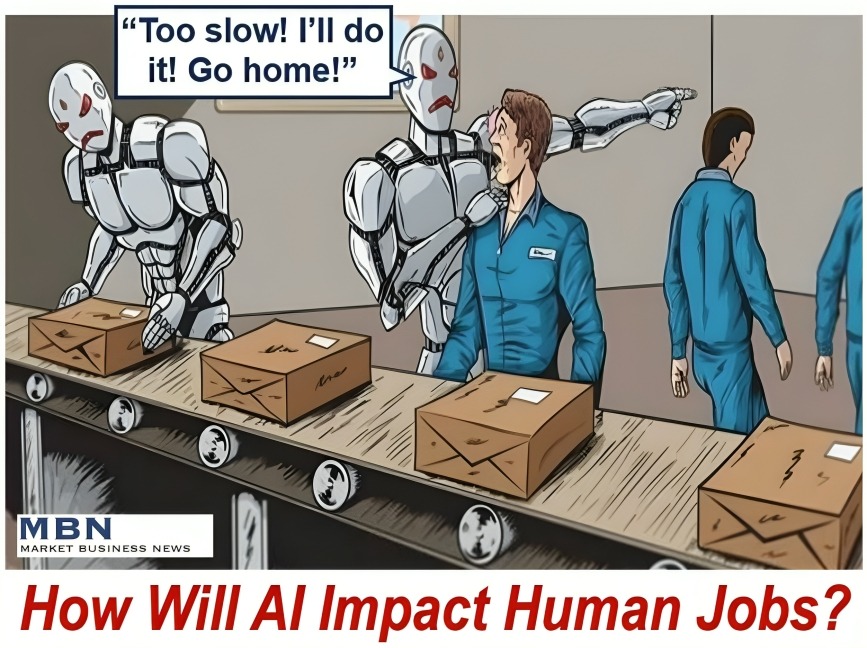The rapid advancement of *artificial intelligence (AI) is changing the landscape of human employment, with some professions at higher risk of replacement than others.
* The term Artificial Intelligence or AI refers to software technologies that enable machines, such as computers or robots, to simulate human thinking and behavior. In other words, it makes smart machines think and behave like human beings.
As AI technology continues to evolve, it raises important questions about which jobs are most vulnerable and how society can adapt to these changes.
Recent studies and reports from various organizations have shed light on AI’s potential impact on the global workforce, with both optimistic and concerning projections.

Image created by Market Business News
The Impact of AI on Jobs: A Growing Concern
-
Canada
According to a report from Statistics Canada, approximately 60% of Canadian jobs are exposed to AI in some way. This includes positions where AI complements human work, potentially boosting productivity, as well as jobs where AI could fully replace human tasks.
The report categorized workers into three groups: those in high-exposure jobs that complement AI, those in high-exposure jobs that could be replaced by AI, and those in low-exposure jobs. Interestingly, the report highlighted that highly educated workers may be more exposed to AI-related changes than their less-educated counterparts.
In fact, 50% of workers with a bachelor’s degree or higher are in jobs highly exposed to AI.
-
The US and Mexico
The story is similar across borders. A report by the Inter-American Development Bank estimates that in just one year, 43 million jobs in the United States and 16 million in Mexico will be affected by AI.
These figures are expected to rise to 70 million and 26 million, respectively, over the next decade.
However, the report clarifies that this doesn’t necessarily equate to job losses; rather, it highlights the occupations that are vulnerable to significant transformation due to AI advancements.
Which Jobs Are Most Vulnerable to AI?
-
Routine Tasks vs. Creative Jobs
One of the key aspects of AI’s impact is the nature of the tasks being performed. Occupations that rely heavily on routine tasks are more likely to be replaced by AI, while jobs requiring human creativity, critical thinking, and emotional intelligence may not be as vulnerable.
-
Telemarketing & Machine Operators
For example, positions such as telemarketing and machine operators are at high risk of replacement, while roles like teaching, firefighting, and even certain medical professions are more secure.
In an article from The Conversation, the report emphasizes that while many jobs may be exposed to AI, it is not necessarily a cause for panic.
-
Productivity in Healthcare and Education
The integration of AI into the workforce can enhance productivity in certain fields, such as education and healthcare. In these areas, AI can be used to support human workers rather than replace them.
-
Jobs in Finance & Insurance
On the other hand, jobs in finance and insurance may be more susceptible to AI-driven changes.
The article also raises concerns about the potential for AI hype, urging governments to critically assess how AI is truly being implemented, rather than succumbing to inflated predictions.
Opportunities and Challenges for Workers
Despite the fear surrounding job displacement, there are opportunities for new roles to emerge. Historically, technological advancements have caused shifts in the job market, leading to the creation of new occupations rather than an overall reduction in employment.
-
Industrial Revolution
For example, the Industrial Revolution caused similar concerns, yet it ultimately resulted in the development of new industries and job categories. AI may follow a similar path, creating jobs that focus on managing and collaborating with AI systems.
-
Gender Disparity
However, these shifts will not be evenly distributed across all sectors. Women, for instance, are expected to be disproportionately affected by AI-driven changes, as they are more likely to hold administrative, support, and service jobs that are vulnerable to automation.
A study by the Inter-American Development Bank found that 40% of women in the United States and Mexico will be affected by AI task automation, compared to 38% of men.
This gender disparity underscores the importance of considering social and economic factors when developing policies to address AI’s impact.
Education and Policy: Keys to Navigating the AI Revolution
-
Education & Retraining Programs
To mitigate the potential negative consequences of AI, experts are recommending significant investments in education and re-training programs.
By focusing on developing skills that are complementary to AI—such as creativity, emotional intelligence, and critical thinking—workers can better adapt to the changing job market.
-
Social Safety Nets
Governments and private institutions must also strengthen social safety nets, ensuring that individuals who lose their jobs due to AI have the support they need during the transition.
Final Thoughts
In conclusion, while AI poses challenges to the workforce, it also presents opportunities for innovation and productivity.
The key to navigating this transformation lies in education, re-training, and policy development aimed at supporting workers in adapting to the future of work.
The roles most at risk are those reliant on routine tasks, while jobs requiring human insight, creativity, and interpersonal skills are likely to endure.
Governments, businesses, and individuals must work together to ensure that the benefits of AI are shared equitably across society, while minimizing its potential downsides.
